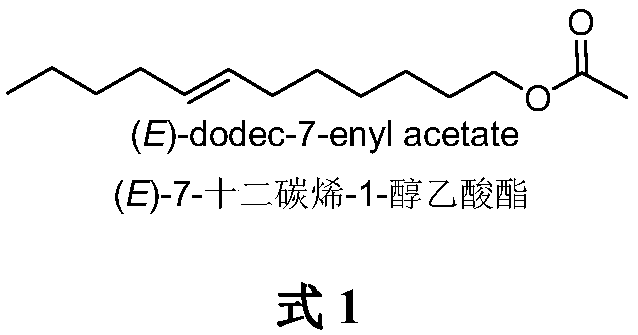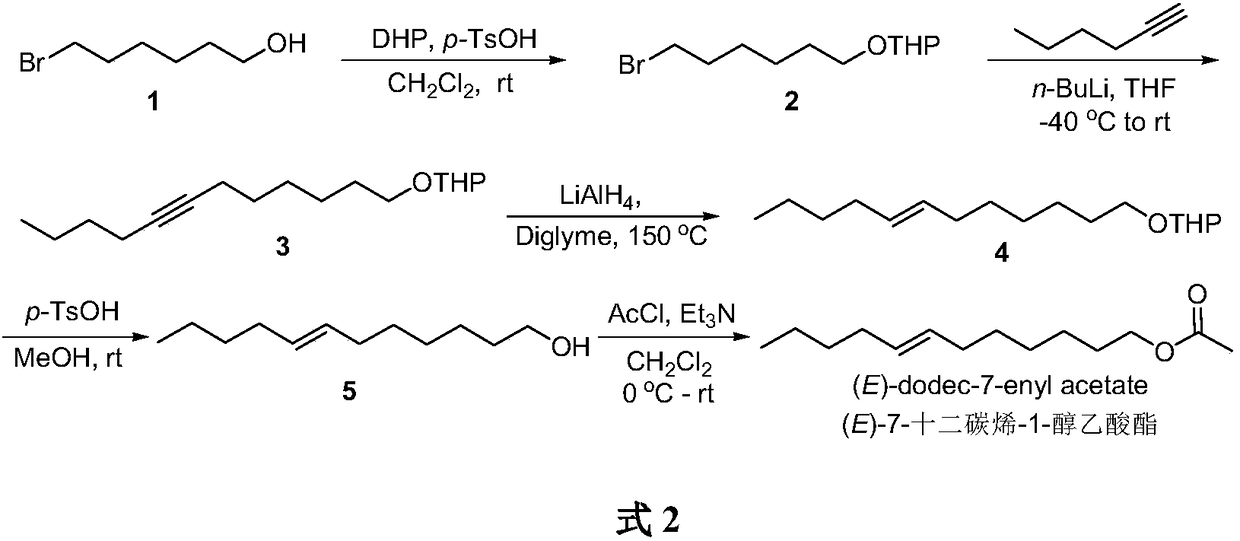Method for synthesizing (E)-7-dodecen-1-ol acetate
A technology of dodecene and alcohol acetate, applied in the field of insect pheromone synthesis, which can solve the problems of cumbersome reaction steps and harsh reaction conditions
- Summary
- Abstract
- Description
- Claims
- Application Information
AI Technical Summary
Problems solved by technology
Method used
Image
Examples
Embodiment 1
[0024] Synthesis of 1-tetrahydropyranyloxy-6-bromohexane 2
[0025] 6-Bromohexanol 1 (1.0 g, 5.52 mmol) and 2,3-dihydropyran (0.95 g, 11.03 mmol) were added into dichloromethane (10 mL), stirred and dissolved. Then p-toluenesulfonic acid (0.1 g, 0.58 mmol) was added and the reaction was stirred overnight at room temperature. After the reaction was completed, the reaction mixture was washed with saturated Na 2 CO 3 Wash with aqueous solution (20 mL), and separate the layers. The aqueous phase was extracted with dichloromethane (3 x 20 mL), and the organic phases were combined. Anhydrous Na 2 SO 4 Dry and concentrate under reduced pressure to obtain crude product. The crude product was purified by silica gel column chromatography (petroleum ether / ethyl acetate 80:1) to obtain 1-tetrahydropyranyloxy-6-bromohexanol 2 as a light yellow liquid (1.36g, yield 93%) . 1 H NMR (300MHz, CDCl 3 )δ4.55(t,J=3.5Hz,1H),3.84–3.70(m,2H),3.41–3.35(m,4H),1.87–1.37(m,14H); 13 C NMR (75MHz...
Embodiment 2
[0027] Synthesis of 1-tetrahydropyranyloxy-7-dodecyne 3
[0028]Under the protection of argon, 1-hexyne (0.79 g, 9.6 mmol) was added into tetrahydrofuran (20 mL), stirred and dissolved at room temperature. The temperature of the mixed solution was lowered to -40°C, and n-butyllithium (4 mL, 2.4M n-hexane solution, 9.6 mmol) was slowly added dropwise. The reaction was stirred at -40°C for 2h, then 1-tetrahydropyranyloxy-6-bromohexane 2 (1.27g, 4.8mmol) was added, the reaction solution was naturally warmed to room temperature, and the reaction was continued to stir for 24h. After the reaction was completed, the temperature of the reaction solution was lowered to 0° C., the reaction was quenched with a small amount of water, the layers were separated, and the aqueous phase was extracted with diethyl ether (3×10 mL). Combined organic phases, anhydrous Na 2 SO 4 Dry and concentrate under reduced pressure to obtain crude product. The crude product was purified by silica gel colu...
Embodiment 3
[0030] Synthesis of (E)-1-tetrahydropyranyloxy-7-dodecene 4
[0031] Under the protection of argon, in the diethylene glycol dimethyl ether (40mL) solution of lithium aluminum hydride (114mg, 3mmol), add 1-tetrahydropyranyloxy-7-dodecyne 3 (266mg, 1mmol ), and stir well. The temperature of the reaction solution was raised to 150° C., and the stirring and reflux reaction was continued for 24 h. After the reaction was completed, the temperature of the reaction solution was lowered to 0° C., and the reaction was quenched with methanol (2 mL) and aqueous ammonium chloride. After suction filtration, the solid was washed with diethyl ether (30 mL), and the filtrate was washed with water (30 mL) and separated. Combined organic phases, anhydrous Na 2 SO 4 dry. Concentration under reduced pressure gave the crude product, which was purified by silica gel column chromatography (petroleum ether / ethyl acetate 110:1) to obtain (E)-1-tetrahydropyranyloxy-7-dodecene 4 as Pale yellow liq...
PUM
 Login to View More
Login to View More Abstract
Description
Claims
Application Information
 Login to View More
Login to View More - R&D
- Intellectual Property
- Life Sciences
- Materials
- Tech Scout
- Unparalleled Data Quality
- Higher Quality Content
- 60% Fewer Hallucinations
Browse by: Latest US Patents, China's latest patents, Technical Efficacy Thesaurus, Application Domain, Technology Topic, Popular Technical Reports.
© 2025 PatSnap. All rights reserved.Legal|Privacy policy|Modern Slavery Act Transparency Statement|Sitemap|About US| Contact US: help@patsnap.com


